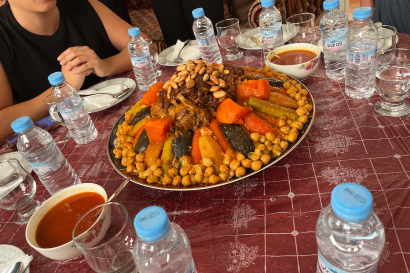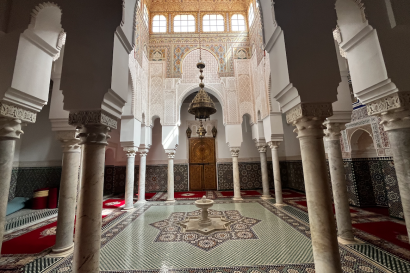This past weekend, my program took a field trip to the cities of Fes and Meknes. Although we had a lot of great experiences and saw some incredible sights, I wanted to share some highlights here. If you ever visit Morocco, these are cities you shouldn’t miss.
We saw a lot during our tour of Fes, but our visits to the fabric market, tannery, and Al-Attarine Madrasa were the most meaningful. We started with the fabric market, where workers showed us what the general process was for extracting silk from cacti, weaving fabrics, and selling them. The fabrics they created in that shop were absolutely stunning, and some of the larger pieces took days to create, especially if they contained stripes. Striped handmade fabrics are generally more expensive because they take longer to make – for every stripe, the weaver must re-thread and re-bobbin the entire machine. At the fabric market, we also learned about different head coverings around the country and how every region’s style is different! The speaker also showed us a head covering that we’ll likely wear when we visit the Sahara because it covers the wearer’s mouth and nose, preventing sand from getting in.
We all loved the fabric market and some of us bought items to take home, then it was off to the tannery. The tannery was fascinating – I’ve never seen so much leather in my life. Bags lined the walls and ceiling, all in different colors and styles. It was a beautiful sight, but the smell was (to be blunt) absolutely rancid. The workers gave us some fresh mint to hold up to our nose with the hope of distracting from the stench, but we couldn’t ignore how bad it smelled. I’m having trouble even coming up with a description of the smell, but I can say that even just looking bad at the pictures sends it right back up my nose. Despite the smell, it was interesting to watch the process that a hide goes through to become leather, and some students got great deals on beautiful items.
The tour then continued to the Al-Attarine Madrasa, which is probably the most gorgeous thing I’ve seen in Morocco (and maybe my entire life). The Madrasa’s original purpose was as a religious school in which students could choose one of two tracks – science or religion (the religion being Sunni Islam). Although the Madrasa’s purpose was intended as a school, its ultimate role has become as art. Our guide informed us that the intricate architecture was not without meaning; every tiny detail of the Madrasa had some sort of significance. Quranic script was painstakingly chiseled into every inch of the walls, and our guide pointed out that while a lot of the mosaic and tile work could be done in another location then brought to the Madrasa during construction, the carving of plaster had to be done on-site. It was the last detail to be added to the building. In addition to the calligraphy on the walls, the mosaics struck me as particularly stunning, and I was excited to find out that they were not simply for decoration. Every tile of the mosaics had a particular meaning which could be derived from its color and shape. Most of the meanings had to do with Islamic faith, and it was fascinating to learn about the significance behind them.
We departed Fes and left for Volubilis, just outside of Meknes, the next day. Volubilis, known as Walili (pronounced “Wahleelee”) in Arabic and Amazigh, Volubilis was a city built and occupied by the Roman Empire for about 400 years. Today, it stands in remarkable condition, considering that it took significant damage from an earthquake in the 1700s. Shortly after, excavation of the site began under French rule and continues to this day. Today, archeology students work year round to dig up more of Volubilis’s history. This task must be particularly hard in the summer, because the day we visited it was 100 degrees Fahrenheit! We all were sweating buckets just walking around the site, nevermind digging it up! Even though it was incredibly hot, Volubilis was still remarkable. The most magnificent structures (in my humble opinion) were the Temple of Jupiter and Volubilis’s version of the Arc de Triomphe. It’s amazing that these remains haves stayed standing despite thousands of years’ time. There were also gorgeous mosaic floors that were still in tact, many of which portrayed popular Roman gods and goddesses. I was a Latin student in high school, so this all was very exciting for me! I may not have been able to see Pompeii after learning about The Illiad and The Odyssey, but Volubilis was more than interesting enough!
After Volubilis, we headed off to the Royal Stables in Meknes! The royal stables were built under the rule of Moulay Ismail, who really loved his horses. His horses were completely pampered, and he ordered the construction of stables which would house his 12,000 royal horses. The indoor stables were considerably cooler than the hot day outside due to the thickness of the plaster walls, an architectural feat I was particularly grateful for on that day. Remember that 18th century earthquake that almost destroyed Volubilis? Our guide informed us that the indoor stables were able to withstand the very same earthquake because the architects had made the structure flexible with earthquakes in mind! The outdoor stables were also remarkable, with corridors stretching every which way. Our guide told us that it was one of the best places to play hide and seek in Morocco because of how many pillars you can hide behind!
As you can see, our weekend was absolutely packed! I had a lot of fun exploring other cities in Morocco, but I was definitely excited to get back to Rabat and get some rest! Nashoofik min baad! See you later!

Alex Ennes
<p>Alex Ennes is a sophomore majoring in English (Creative Writing concentration) with minors in Arabic and Criminal Justice. She comes from Cape Cod, Massachusetts, where she enjoys spending her time reading and writing on the beach or taking her dogs for walks down to the dock! Alex currently lives in Philadelphia exploring her passions for reading, writing, learning languages, and playing music at Temple University, where she is also a Resident Assistant and Owl Ambassador (tour guide). Alex will be spending Summer 2017 in Morocco through IES Abroad's Rabat Summer: Francophone Studies and Arabic Language Program.</p>








